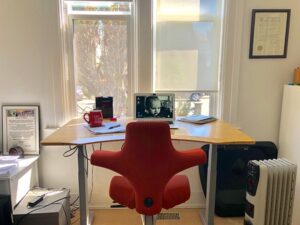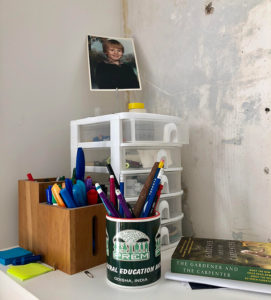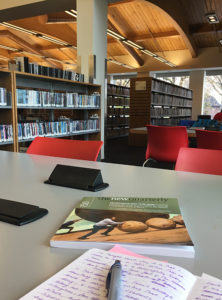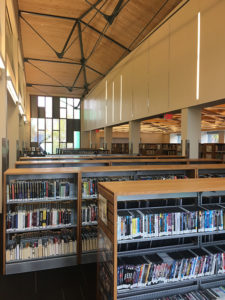Richard A. Johnson’s Writing Space
It’s daybreak in Victoria, mid-spring, which means the dawn light creeps through the gaps in the window shade at 5 a.m. and by 5:30 I’m sitting at my desk next to a steaming cup of black coffee. With any luck, our 22-month-old son has slept solidly through the night and won’t be jumping in his crib, knocking on the adjacent wall, or running into my office to bang on the old Mac, for at least another hour. By which time my wife will be up to handle morning routines and allow me another precious hour or two to remain embedded in the work of drafting, editing, or procrastinating.
 “Writing is done in solitude,” wrote Rebecca Solnit, “but not in isolation.” I adore the Writing Space section of TNQ’s website because I spend a lot of downtime imagining idyllic writing spaces and the solitary writers who inhabit them. My favourite physical element of my own space is an adjustable, electric standing-desk (a “most luxurious item,” confessed Ayelet Tsabari of hers, and rightly so). A few years ago I spent the weekend before my birthday visiting friends out of town, and when I returned my wife had replaced my decrepit IKEA desk with this beauty. At first it felt too luxurious—a desk fit for an elite novelist, perhaps; not an imposter and word-grinder who spends no small amount of his time editing corporate reports and listicles. (I got over that feeling when I played with the control panel.)
“Writing is done in solitude,” wrote Rebecca Solnit, “but not in isolation.” I adore the Writing Space section of TNQ’s website because I spend a lot of downtime imagining idyllic writing spaces and the solitary writers who inhabit them. My favourite physical element of my own space is an adjustable, electric standing-desk (a “most luxurious item,” confessed Ayelet Tsabari of hers, and rightly so). A few years ago I spent the weekend before my birthday visiting friends out of town, and when I returned my wife had replaced my decrepit IKEA desk with this beauty. At first it felt too luxurious—a desk fit for an elite novelist, perhaps; not an imposter and word-grinder who spends no small amount of his time editing corporate reports and listicles. (I got over that feeling when I played with the control panel.)
We moved to Victoria from Toronto last summer, and by necessity that meant letting go of an old space—and many of its resident objects—and populating a new one. The choice of what to keep and what to discard came down to a decision about the nature of inspiration: What do I need to surround myself with in order to write? Marilyn Bowering wrote of the things she carried from one writing space to the next that they bestowed a feeling of “continuity to a journey which has often felt navigated blind.” Continuity. So I Marie-Kondo’d most of the décor and detritus (and a few of the books) from the old space and pared myself down to only those things that are essential to the continuation of my story. In addition to old journals and a haphazardly curated selection of mostly non-fiction books, there remain dictionaries, style guides, a few pretty perfect-bound magazines, and a cherished 1940 edition of Leaves of Grass. Plus a photo of myself, age six, which reminds me to be honest with my stories and not to take myself too seriously. (Ain’t no such thing as a six-year-old imposter.)
 In fact, this writing space of mine is a shared space—my wife takes over between 8:30-5:30 most days to produce exquisite podcasts, while I spend the day happily ensconced in the mind-bending world of fatherhood. Susan Olding wisely admitted that “a lot of the real work of writing gets done outdoors when I’m walking,” which is absolutely true. Fatherhood, too, is an outdoor pursuit, and while my creative brain hibernates as I herd a proto-toddler around parks, beaches and neighbourhood nooks, my reflective brain gathers perspective and silently edits whatever claptrap I penned that morning. When my fingers escape the firmness of the keyboard and sink into the wet sand of a low-tide beach, drawing triangles and stick figures, I feel something honestly refreshing, intimate and authentic—much like the feeling of a creative breakthrough.
In fact, this writing space of mine is a shared space—my wife takes over between 8:30-5:30 most days to produce exquisite podcasts, while I spend the day happily ensconced in the mind-bending world of fatherhood. Susan Olding wisely admitted that “a lot of the real work of writing gets done outdoors when I’m walking,” which is absolutely true. Fatherhood, too, is an outdoor pursuit, and while my creative brain hibernates as I herd a proto-toddler around parks, beaches and neighbourhood nooks, my reflective brain gathers perspective and silently edits whatever claptrap I penned that morning. When my fingers escape the firmness of the keyboard and sink into the wet sand of a low-tide beach, drawing triangles and stick figures, I feel something honestly refreshing, intimate and authentic—much like the feeling of a creative breakthrough.
And when I return to the writing space in the evening, after supper and stories and bedtime routines—assuming I have a nickel of creativity left to spend—I raise the desk and tap my fingers and become writer-like again. Even if all I’m doing is, in the familiar words of Richard Kemick, staring “into the abyss of draft number seven.” The abyss, to paraphrase Joseph Campbell, is where you find the treasures of life.
Ergo, writing space: a good place for a treasure hunt.
(I don’t tweet much but hit me up @writing_richard if my writing space feels at all familiar to you. Solitude, not isolation, right?)
Photos courtesy of Richard A. Johnson.



